With all the different classes and types of RVs, it can get a bit confusing when talking with someone about their latest trip with their RV, camper, or motorhome. You’ll also want to know more about the different classes if you are getting ready to buy a new RV.
The biggest differences between the different classes of RVs are their size, shape, and cost. They are categorized into three different classes. The largest being a Class A motorhome, followed by a medium sized Class C, and a smaller class B. These range in price anywhere from $10,000 to $300,000.
This illustrated guide will help you to spot the differences and know which one is right for you.
RV Basics
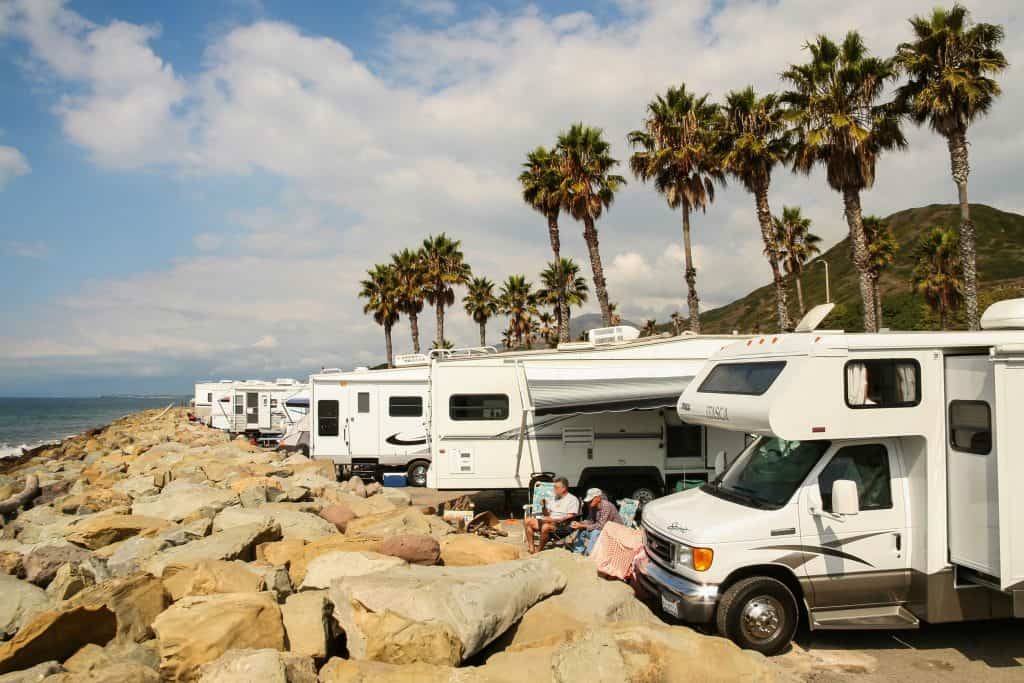
When deciding on which RV Class is right for you, there are a few things to consider:
- Does your state require a specific license? (This varies from state to state and the weight of your RV, but most only require you to have a basic driving license)
- How many people will you be sleeping on this trip?
- How much will you be traveling; will you stay in one location or traveling to multiple stops?
- What is your budget as far as gas mileage and insurance go?
- What type of vehicle do you have and how much weight is it fit to tow?
- Or would you rather tow your vehicle behind your RV?
- Are there specific rules or regulations concerning RVs in your residence?
| RV Class | Length (in feet) | Sleeping Capacity | Price (new) | Weight |
|---|---|---|---|---|
| Class A | 21-45′ | 1-8 people | $50,000- $100,00 | 13,000- 30,000 lbs. |
| Class B | 17-19′ | 1-4 people | $40,000- $80,000 | 4,000- 9,000 lbs. |
| Class B+ | 20-30′ | 1-8 people | $50,000- $65,000 | 7,000- 12,000 lbs. |
| Class C | 20-31′ | 1-8 people | $50,000- $80,000 | 10,000- 13,000 lbs. |
Class A
If you’re looking for luxury, then the Class A RVs are definitely for you. With lots of space, plenty of amenities, and an overall beautiful interior–I don’t know what else can spell out luxury in RV form.

Class A motorhomes or RVs are probably the most comfortable option out there because of how big they are as well as the great driving experience. In the most basic sense, Class A motorhomes are typically a bus turned into living quarters.
They come with all of the necessary amenities like a kitchen and bathroom and can feel like you’ve taken your home with you in your RV. This makes it better for longer stays in one location. It’s also pretty great if you plan on spending a lot of time on the road.
Did you know that Class A RVs could even have a washer and dryer hooked up inside of it? Is that neat or what?
On top of that, they could also include a sort of garage part known as a toy hauler in the back of it or a mobile garage beneath it where you can store all of your outdoor toys like four-wheelers and dirt bikes.
Typically, this class is the largest and most luxurious class of all of the motorhomes, and to the experienced RV enthusiast, it is definitely worth the price.
As that is, it also tends to be the priciest of all of the different RV classes. Let’s face it, you’re not going to get a giant home with king-sized beds and a washer and dryer for free or even a remotely low price.
But it’s worth it, right? I mean, you get what you pay for.
This class of RVs is also typically the least fuel efficient out of all of them, but don’t let that deter you from getting in on the great experience that Class A RVs can give you on your trips.
Other things to look out for if you do end up deciding on a Class A RV include backroads and special parking facilities. Because of its large size and weight, the Class A RV usually isn’t the best at handling steep inclines, sharp turns, or potholes that one might encounter when taking the backroads.
Along with that, Class A RVs are usually too big to be parked along the road or even in some driveways in residential neighborhoods when they’re not in use. This means that you’ll have to plan on storing your Class A RV in a special parking facility instead during the off seasons.
Class B
So, you’re looking for an RV that might be a bit more fuel efficient and a little nicer on your budget? That’s okay. Class B RVs could be a great fit for you and your budget, as long as you don’t mind the size.

Unlike the Class A RVs, this class is typically the smallest of all of the RVs. As that is, this is one of the more common choices just because of the more affordable price and the lightness and agility that they can offer with their more compact size.
A Class B is basically a big van that works for camping, but don’t worry, it’s a lot nicer than just living out in a basic minivan just because you can’t afford the rent. It also has enough height so you can stand comfortably inside of it.
You don’t get that from your typical minivan, do you?
Along with the compact size and camper van style, the Class B RVs tend to be easier to drive than the Class A RVs and can usually handle more of the back-road driving.
Most Class B RVs do come with small kitchens and bathrooms, but there is a rather limited living space. However, the most basic could be considered simply as a bed and storage space.
It really depends on what you need it for.
As funny as that sounds though, the Class B RVs, or camper vans, are not exactly known for their storage space once you use up all of the living space. So that is obviously something important to keep in mind if you’ll be needing more storage space for your RV adventures.
On the other hand, there are plenty of added benefits that come with Class B RVs. While Class A RVs can hold a large family comfortably, Class B is a better fit for one to four people, depending on the size. This class is also perfect if you plan on doing lots of traveling on your trip just because they’re more versatile, easier to drive and park, and more fuel efficient than Class A RVs.
In fact, Class B is renowned for being the most fuel efficient out of all of the different RV classes.
I mean, what else would you expect from a camper van compared to giant portable homes?
Class B+
I know, it sounds funny, but I promise it actually exists. Class B+ RVs are a more modern hybrid between Class B and Class C RVs.

Basically, what makes Class B+ different from the regular Class B is just that they are overall a bit bigger and offer a few more luxuries. It is still based on a van, but a slightly larger one.
Class B+ RVs can give you a standing shower/bath combo as well as larger kitchens, living space, and sleeping areas. With all of that extra space, the Class B+ RVs tend to offer more comfort than the Class B or Class C RVs. They can also sometimes include sofas or extra twin beds to add to that extra comfort.
Honestly, if the storage space issue from the regular Class B RVs disappointed you, but you don’t need all of the extra bells and whistles that come with Class A or Class C RVs, then a Class B+ RV is definitely going to be a better choice for you.
While they are nice and comfortable, adding the extra space and amenities does, unfortunately, mean taking away from some of that fuel efficiency that you can find in the Class B RVs.
Overall, the main deciding factor between choosing a Class B+ RV and a regular Class B RV will be how many people you will be housing in your RV for your trip.
Class C
And then you have the in-between. Don’t let the letter-order confuse you; it may come later in the alphabet, but it is surely not the smallest, least expensive, or least exciting. I know. It can get confusing, but you just kind of learn to go with it.
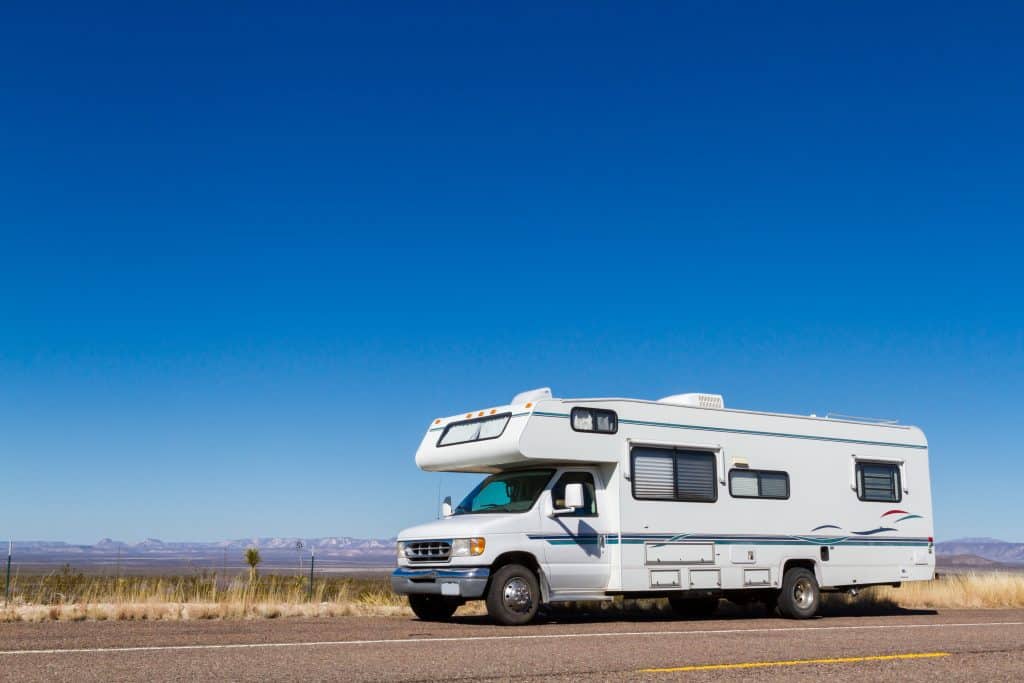
Class C is pretty similar to Class A RVs, but smaller, which also means that it is also slightly less expensive than Class A. A Class C RV is basically a motorhome built on top of a modified pick-up chassis. This means that the living quarters are typically in a sort of cab right above the driving area.
Because of this, there is some pretty convenient extra living space in the Class C RV. I don’t know about you, but I think it sounds pretty nice.
Class C RVs also come with all of the same amenities as Class A so it can keep you pretty comfortable. This class of RVs usually cannot handle something behind it like another vehicle unless a toy hauler has been built in.
However, there have been some newer versions recently made that can actually handle towing an extra vehicle behind it.
As for the gas mileage and fuel efficiency of Class C RVs, it’s pretty much in the middle of what you would expect from the Class A and Class B RVs.
Basically, the Class C RVs are for people who want something smaller and slightly more affordable than Class A but aren’t ready to take on the compacted excitement of a camper van (AKA Class B RVs).
It’s okay to admit your inability to handle the smallness and simplicity of Class B RVs. There’s no judgment here. I mean, besides the judgment you just passed on those poor camper vans… but really, no hard feelings.
Anyways, this class, since it is attached to a pick-up, also includes all of the towable RVs and travel trailers that can be hard or soft-sided and typically attach to a hitch behind the vehicle.
| Trailer Type | Length (in feet) | Sleeping Capacity | Price (new) | Weight |
|---|---|---|---|---|
| Pop-Up Trailer | 8-16′ (box only) | 1-6 | $7,000- $50,000 | 600- 4,000 lbs. |
| Hybrid Trailer | 16-30′ (un-extended) | 1-6 | $8,000- $50,000 | 2,000- 5,000 lbs. |
| Airstream | 23-33′ | 1-5 | $50,000- $100,000 | 2,500- 4,000 lbs. |
| Teardrop Trailer | 4-6′ | 1-2 | $7,000- $12,000 | 520- 2,000 lbs. |
| Fifth-Wheel Trailer | 30-45′ | 1-8 | $50,000- $150,000 | 2,400- 20,000 lbs. |
| Truck Camper | 6-9′ | 1-3 | $8,000- $50,000 | 1,000- 5,000 lbs. |
Pop-Up Travel Trailers
Pop-up travel trailers, unlike the traditional hard-sided travel trailers, usually have sides made of something softer like canvas. This makes them pretty light-weight, easy to tow around, and can even trail behind a simple SUV.
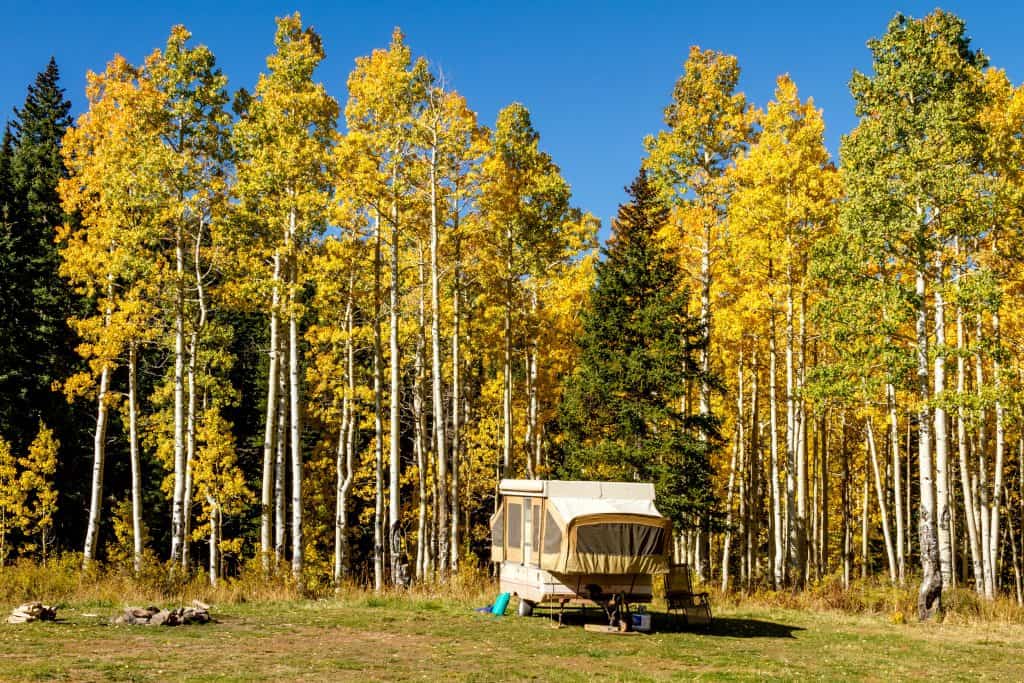
The pop-up travel trailers can almost be compared to a tent on wheels, but nicer. I don’t know. I think it has a certain appeal to it that sounds like not a lot of work to take it on a trip.
The pop-up travel trailer usually includes a couple of double beds, a sleeping area, a small dining area, a sink, and cooktop. Basically, the pop-up travel trailer is sure to make your camping experience both fun and convenient. And, you know, you’re not sleeping on the ground, so that’s always a plus.
Though the pop-up travel trailer does not require any special storage conditions and can handle being left outside on its own, as long as it is left folded up rather than kept open, it’s so small that it can be stored inside a garage in between trips if you wanted to.
Talk about convenient, right?
One thing to keep in mind about the pop-up trailers is that they aren’t exactly insulated for cold weather. Being relatively the same material as a tent and working as a tent, it should probably be treated pretty similarly to a tent in the way that I wouldn’t recommend taking it to extremely cold or precipitous climates.
The Hybrid Travel Trailer

If you want something with just a bit more stability than the fully soft-sided pop-up trailer, but still like the idea of an expanding or extending trailer, then maybe you should consider the hybrid travel trailer.
This trailer is a hybrid between the traditional hard-sided travel trailer and the pop-up trailer in the way that it is hard-sided, but it has pop-outs for the sleeping quarters.
It also has the basic amenities that the pop-up trailer has, and maybe a few more if you’re lucky.
The added benefits of the hybrid travel trailer are that it is pretty lightweight, and the pop-outs mean extra space. The pop-outs also make it to where everyone can sleep on queen-sized beds for the trips. Doesn’t that sound so nice?
Some of the downsides to the hybrid travel trailer include having to take a few minutes out of your time to set up the pop-outs as well as having to air out the travel trailer when it rains because the soft-sided pop-outs aren’t always completely weatherproof.
But don’t let this deter you from getting one of these fantastic hybrid travel trailers.
The Airstream
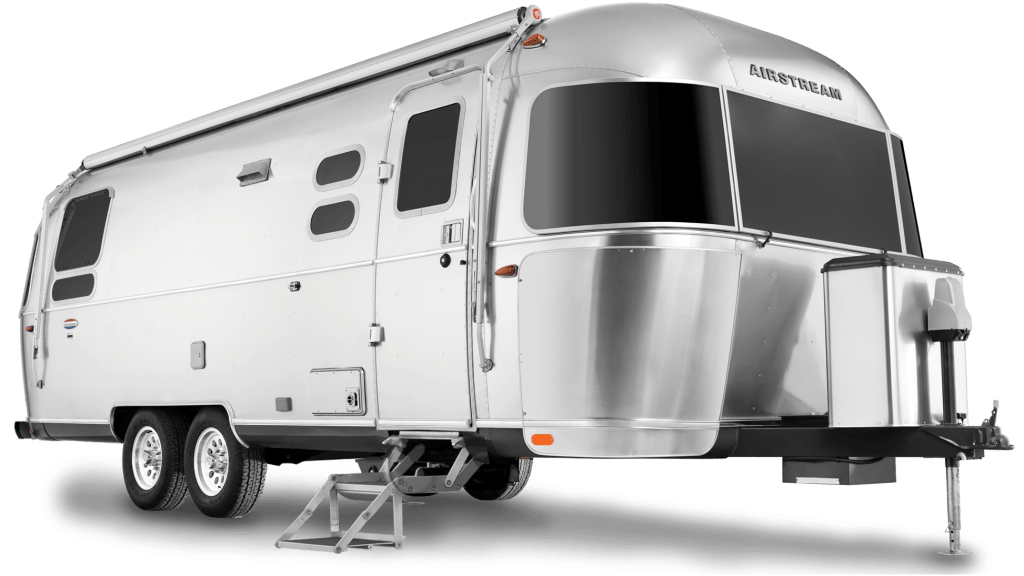
First of all, isn’t that name impressive? The best part is that the travel trailer itself looks just as impressive as it sounds.
The Airstream is probably one of the more sturdy and durable of all of the travel trailers. It comes with a nice metal enclosure that makes it to where there are fewer leaks (of any sort) than your typical travel trailer, and there are tons of windows.
The Airstream should have all of the basic amenities of a regular Class C RV. Some of the classier, usually more expensive versions of the Airstream even come with a full, residential-style kitchen.
Is that fancy, or what? I wouldn’t mind getting myself one of those.
Sure the metal enclosure might mean it could get a bit dinged up on the outer shell, but that definitely does not ruin the overall experience in this travel trailer.
It might be a bit expensive, but it is well-regarded in the industry and will be easy to refurbish and resell once you decide that you’re done with it or want an upgrade to a larger RV.
Teardrop Trailers
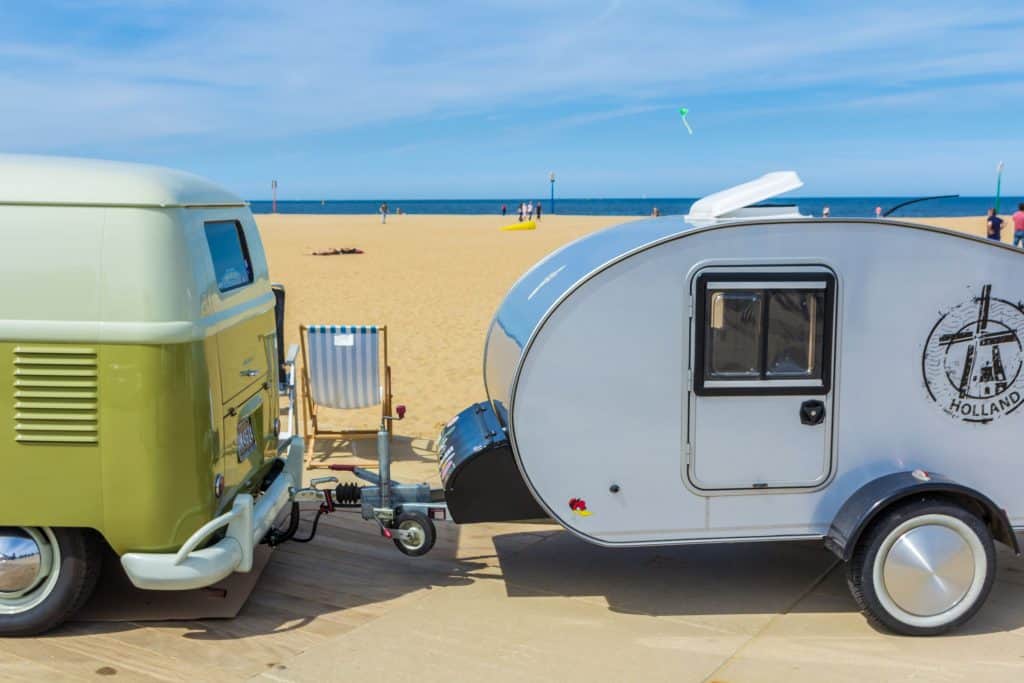
Interested in a travel trailer, but you were hoping for something just a bit smaller and maybe just a tad more budget-friendly? Take a look at the Teardrop travel trailer.
Teardrop trailers are probably one of the cutest travel trailers out there. As the name suggests, they tend to be so small and lightweight that they can be towed behind a simple car.
Because of their small size, they are typically suited for one person and are not recommended for living inside of them, though some of them can come with an adorable kitchenette if you’re lucky.
The teardrop trailer is very agile and can be great for some very basic, single-person or couple camping trips.
Some might call it a sleeping bag on wheels with a roof included, but I like to think that it has just a bit more sophistication than that. It’s perfect for anyone who wants to do some lighter camping but doesn’t necessarily need a huge travel trailer to tow behind them.
Overall, the teardrop trailer is perfect for the RV enthusiast on a budget.
Fifth-Wheel Trailers
The Fifth-Wheel Trailer is a bit different from all of the other travel trailers in the way that it can’t simply attach to a hitch in the back of a vehicle.
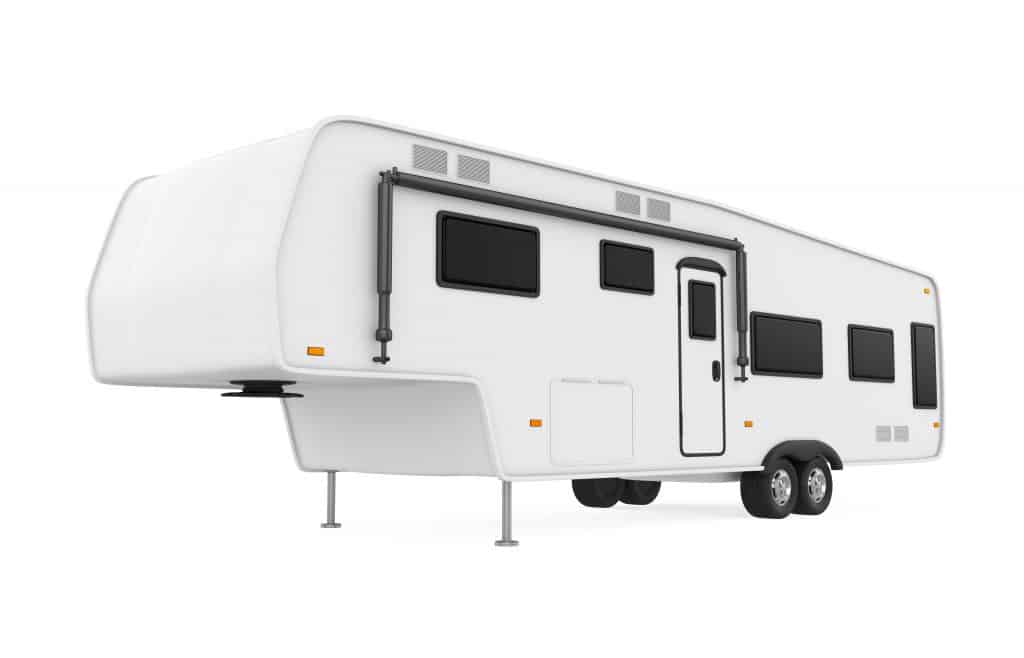
Fifth-Wheels have a special extension that ends in a sort of wheel-like construction (hence the name) that attaches to the bed of a full-sized pick-up truck instead of a simple hitch.
This special extension hitch makes the Fifth-Wheel trailer easier to tow because it doesn’t really sway all the time whenever you turn a corner, as a more basic travel trailer might.
The Fifth-Wheel travel trailer is pretty similar to the Class C of RVs or motorhomes in the way that the trailer extends over the bed of the truck, but really it is more like a Class A RV in the way of comfort, space, and amenities.
Similar to Class A RVs, the Fifth Wheel travel trailer includes convenient slide outs for more space, bathrooms, and sometimes even multiple bedrooms.
The Fifth-Wheel travel trailer also tends to have high ceilings and can be very heavy. In fact, in order to tow a Fifth-Wheel travel trailer, you need to have a very special kind of truck that can handle at least three-quarters of a ton, if not more.
This trailer can also tend to be more expensive than the other travel trailers when you add in all of the extra requirements to tow the trailer, but the cost is worth it to have Class A amenities and comfort inside of a Class C travel trailer.
Truck Campers
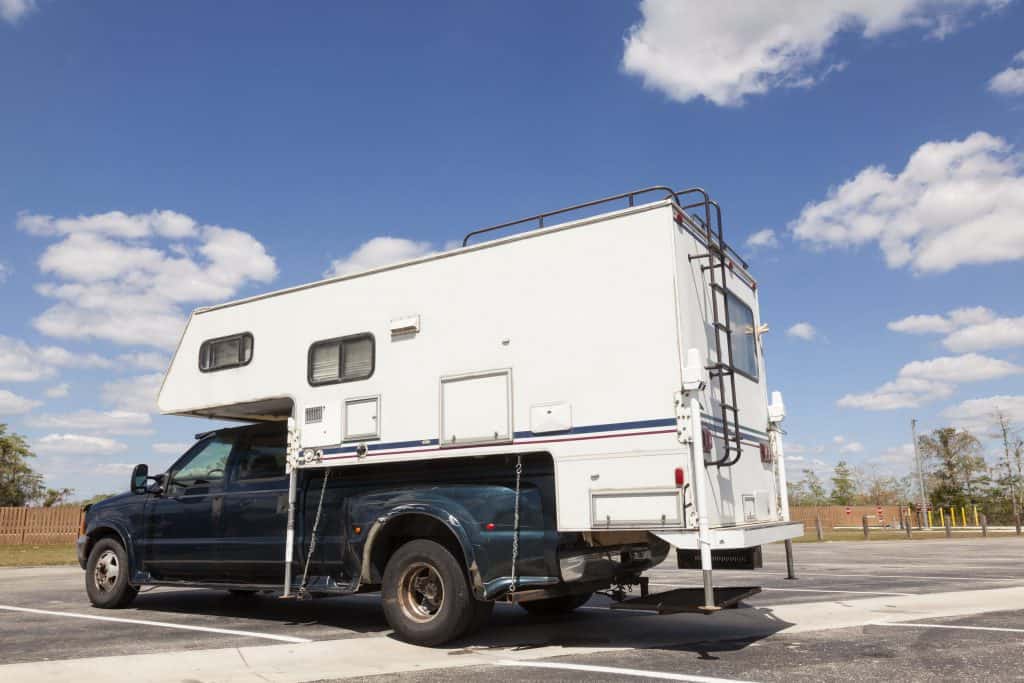
Truck Campers are probably one of the most convenient types of campers just because you don’t need to tow anything behind your vehicle, so it’s less to worry about during the trip.
If you haven’t already guessed it, the Truck Camper can just be put into the bed of a tuck and will fit just about any type of truck you can think of, as long as it has a bed.
As far as measurements of Truck Campers go, they are typically just as long as your truck from the front bumper to the very edge of the truck bed, or it can be one that simply fits into the truck bed and be much shorter.
The most basic types of Truck Campers are pretty simple as far as living quarters go, but they are great for short, little trips like a light hunting or fishing trip over the weekend.
Just take a second to imagine going on a father-son fishing trip, and you bring along the truck trailer instead of a little tent. Can you imagine how nice that would be to have a real bed to sleep on and some extra storage space for your fishing poles and tackle box?
As that is, you can also get the more sophisticated Truck Campers that are meant for more regular stays at the campground. These will usually have more options as far as amenities go, including a rear door, overhead sleeping areas, more beds, and sometimes even some slide outs.
Then you could invite along more people to come with you on that father-son fishing trip.
And yes, in case you are wondering, these handy little Truck Campers do indeed still count as a type of RV, specifically inside of Class C, along with all of its other travel trailer and camper friends.
Just because they fit so nicely inside of the truck bed instead of trailing behind like any of the other more common travel trailers does not mean that it doesn’t fit into the Class C travel trailer classification.
Some Other Restrictions on RVs to Consider
While you are looking into which class of RV would fit you best and all of your needs, you might also want to consider some of these important restrictions and regulations that go along with some, if not all, of the different RV classes.
- Special License: Most states won’t require you to have a license for your Class B, Class C, and sometimes even Class A RVs, but it all depends on the weight and overall size of the RV. It’s important to check with your state first.
- Height Limits: Most states have a height limit of 14′ for all classes of RVs, but there are some states where this can vary.
- Length Limits: The typical RV, no matter the class, is limited to a length of 40-45 feet. This changes when the RV includes a separate trailer and can go as long as 50-65 feet.
- Width Limits: The majority of the states have an 8-foot width limit, but some states, like Connecticut, narrow it down to 7.5 feet in length. The typical Class A RV is only 8 feet wide, but some of the newer ones and even some of the newer Airstreams are 8.5 feet wide.
- Registration Requirements: Each state will typically have different registration requirements that could be based on the RV’s length, weight, type of chassis, etc. It’s important to look into your state’s specific regulations for this before purchasing your RV.
- Trailer Brakes and Hitches Requirements: Many states require RVs to have equalizing hitches and/or breakaway or independent braking systems depending on the weight of the trailer.
These are only the most common restrictions on RVs between states to consider when deciding on which class of RVs you want to go with. Obviously, there are more restrictions and regulations as you go from state to state, and those more specific restrictions and regulations can be found in this handy dandy list here.
More Information
To find out more information about the different classes of RVs and RVs in general, you can watch the video below.

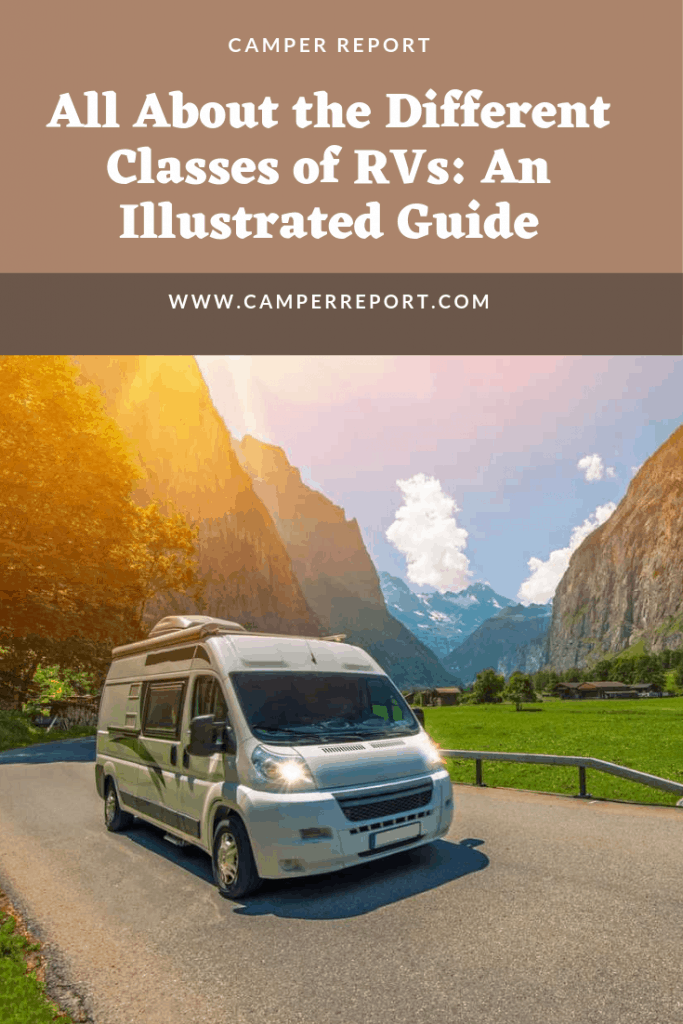
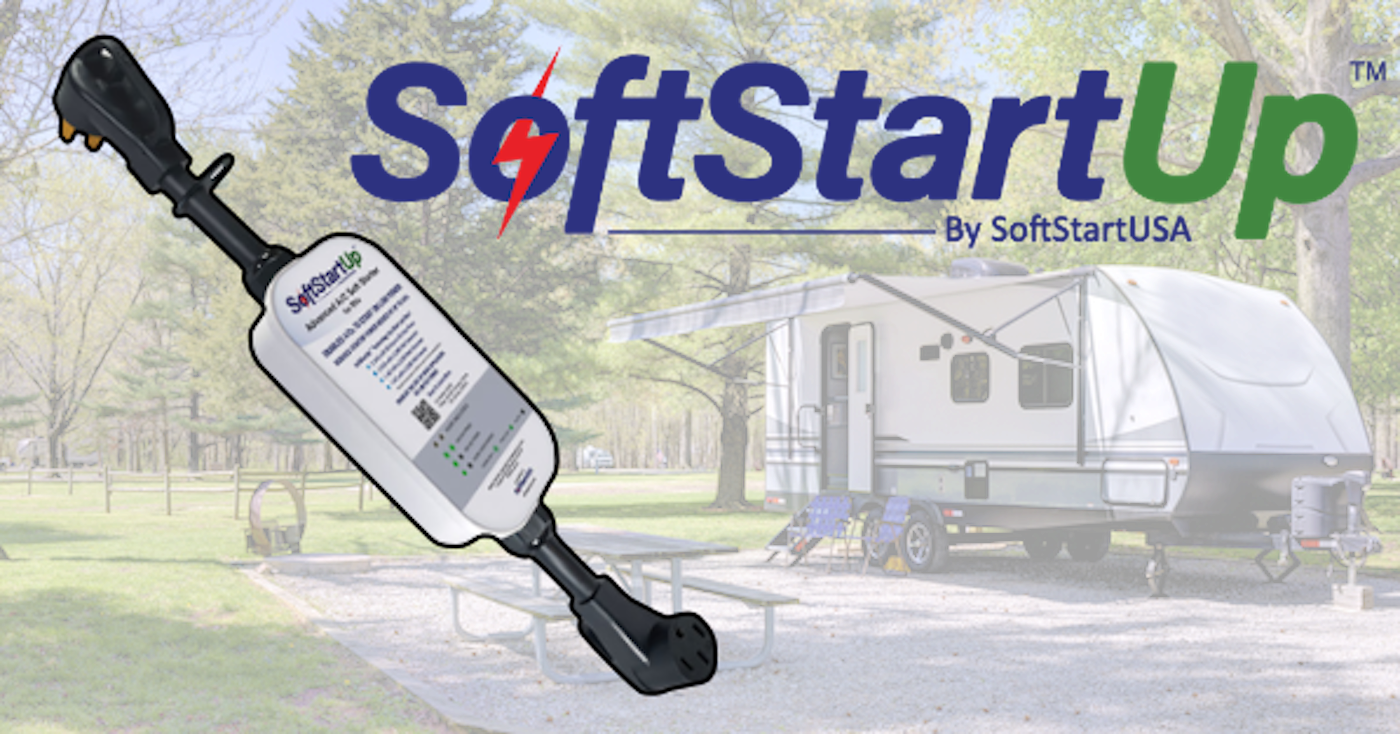
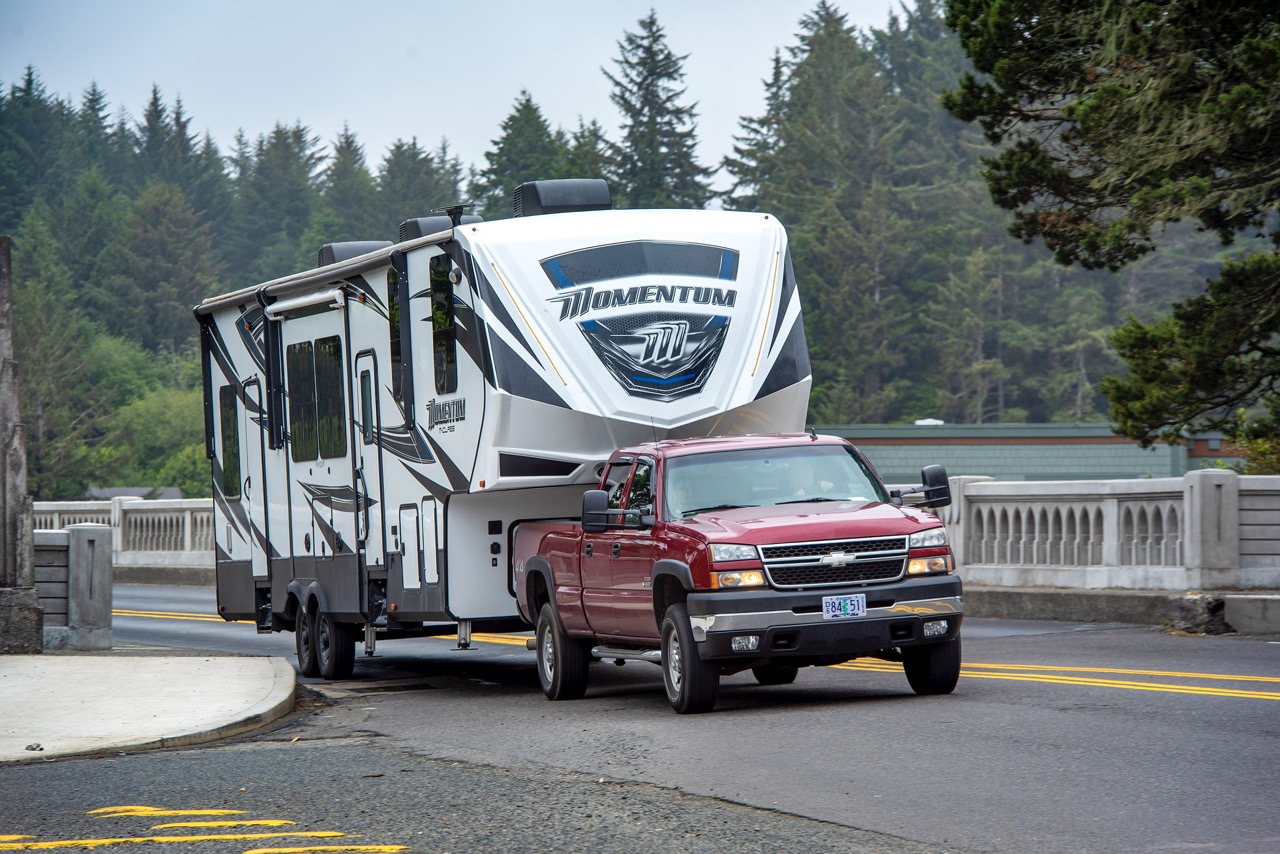

What happened to Travel Trailers? Not all Trailers are Airstream and Airstream doesn’t have things like slid-outs for extra room.